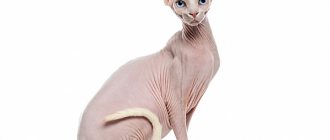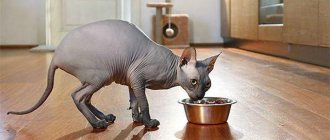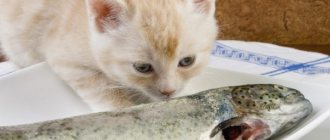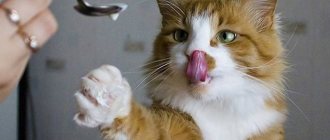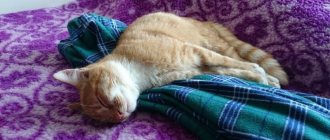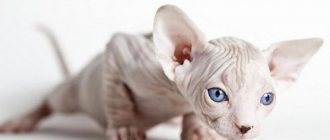Why don't sphinxes have mustaches?
Also, zoologists call them “vibrises”.
In fact, these are not just protruding antennae, but a very important organ of touch. With their help, cats can navigate space very well at night.
Catching air currents with its whiskers, the cat recreates a picture of the environment in its mind, which is vitally important when hunting and climbing trees and thorny bushes.
If you touch the whiskers, the cat reflexively closes its eyes. After all, in place of your finger there could be some kind of thorny branch in the bush. This mustache is a protective mechanism and a means of navigation.
Sphinxes and their mustaches
The Sphynx breed primarily differs from other types of cats in that they have no hair, that is, the hairless gene is genetically dominant. This also applies to the mustache. They are naked-born by nature and the absence of a mustache is the norm.
However, not all sphinxes do not have them. Don Sphynxes may have “broken” mustaches, and also periodically lose or acquire them. Everything is quite individual and depends largely on heredity.
The absence of vibrises is not a deviation. This also applies to the St. Petersburg sphinxes. Canadians don’t have them at all, neither in kittens nor in adults, as well as any hint of fur.
Despite the importance of whiskers for cats, sphinxes feel great in their environment, and, as a rule, they don’t have to climb trees, because that’s not what this wonderful breed is for.
Don't let the lack of antennae on your Sphynx bother you!
More information on Why do sphinxes not have mustaches?
You can receive by leaving a comment.
Source
Wool and leather
The first impression when looking at the Sphynx is the complete absence of fur. However, the breed standard still provides for the presence on the body of the Sphynx of a soft fluff 2 mm long, similar to a suede covering, which is felt at the moment of stroking the kitten. Some parts of the Sphynx's body may have fine hairs, for example, they may be on the tail, limbs, outer part of the ear and scrotum, and there should be normal hair on the bridge of the nose.
The skin of the Sphynx is covered with many folds, the number of which is especially large between the ears, around the muzzle and shoulders. The sphinx may not have a mustache, or it may be short and broken off.
Due to the lack of fur, the requirements for the Sphynx figure are quite high - excess weight and fat folds are excluded.
Why do cats need mustaches?
A cat's whiskers are sensory organs. Their correct name is vibrissae. Translated from Latin, this word means “to wriggle, waver.” With the help of whiskers, the cat receives additional information about the space around it.
The structure of the mustache is similar to ordinary hair, but it is thicker, stiffer, longer and “set” much deeper. If you look closely at any cat, you will find that “whiskers” grow on its cheeks, chin, eyebrows, and even on its front legs and tail.
Each vibrissa hair has an individual neural connection with the brain. They transmit data about the distance to nearby objects and record temperature changes. Whiskers help cats navigate in space, catch the movements of the prey, and accurately calculate the trajectory of the jump. With their help, the animal navigates in complete darkness.
The importance of vibrissae was confirmed during inhumane experiments to remove them.
Cats without whiskers felt worse:
- were clearly disoriented;
- their coordination of movements was impaired;
- could not correctly calculate the distance during a jump;
- “saw” worse in the dark;
- showed clear signs of stress.
For a domestic animal, the temporary loss of a mustache is not as tragic as for a free one. The life of a street cat depends on the ability to accurately navigate in space: to track and catch prey, to defeat an enemy in a fight, to run away and hide from the enemy.
Puberty and mating
For those owners of Canadian Sphynxes who have decided that they want to have offspring from their pet, I would like to draw their attention to some features. They cannot be ignored when mating an animal. To do this, you need to know the process of puberty in cats and male cats of this breed.
The first heat in cats occurs at 6 months, they cannot be bred immediately
Puberty in a cat occurs at 6-7 months. She's going into her first heat. At this time, the cat screams loudly, rolls on its back on the floor, and shuffles its hind legs. There are changes in her behavior. The animal may become aggressive or, conversely, even more affectionate.
Under no circumstances should a cat be mated during her first heat. The animal's body is not fully formed.
Puberty in cats occurs at 8 months.
The first mating of a cat can be carried out after 2-3 heats, cats can be mated at the age of one and a half to two years. Before mating, partners are shown to a veterinarian to confirm their health. 2-3 weeks before mating, for the purpose of prevention, animals are treated for worms. Claws are trimmed 1 day before mating.
You should not wash your cat before mating, as the smell that attracts the cat may disappear.
More often, for mating, the cat goes to visit the “groom”. The cat owner must make sure that the “bride” is comfortable so that she quickly gets accustomed to an unfamiliar environment.
After mating, the cat rolls on its back on the floor, and the cat goes to the side and cleans itself.
Why don't sphinxes have mustaches?
The lack of fur in sphinxes is the result of a random gene mutation fixed by breeders. The balder the cat, the higher the rating he will get at the exhibition.
The Don and St. Petersburg Sphynxes are not without mustaches: they are allowed to have short or curled whiskers. And the presence of vegetation not only on the body, but also on the face of the Canadian Sphynx is counted as a breed defect. Their lack of mustache is a distinctive advantage.
Breeders sought to strengthen the already dominant “bald” gene, as a result of which almost all hair disappeared in subsequent generations.
The absence of any important organ or body function is necessarily compensated. Hairless cats are highly intelligent. Perhaps in this way nature paid them back for the fact that people took their mustaches from them.
However, the absence of vibrissae does not prevent them from deftly climbing, jumping and successfully hunting. No sphinx has ever been harmed because it does not have a mustache.
Health
One of the most common health problems among Sphynx cats is obesity. Due to excess weight, cats become inactive, their joints and internal organs suffer. In this case, it is important not to overfeed the animal and accustom it to the feeding regime.
It is worth noting that Sphynx cats are the most susceptible to infections, so kittens must be vaccinated and regularly shown to a veterinarian. Mature animals get sick quite rarely, but even they have troubles: acne, skin rashes or vasculitis. Also common among Sphynxes are congenital entropion of the eyelids, damage to the spine and tail, and a short lower jaw.
But these four-legged animals can boast of a long lifespan - sphinxes live for about 13-15 years.
Do sphinxes have mustaches?
Breeders have bred the following breeds of hairless cats:
- Canadian Sphynx;
- Don Sphynx;
- Petersburg Sphynx - Peterbald.
The Canadian hairless cat breed is older than the Don and St. Petersburg cats, but they are not related. The ancestor of Canadians was a kitten from Ontario. Donskaya appeared in Rostov-on-Don. Peterbalds were bred by crossing the Sphynx-Donets and the Oriental breed.
Sphynx Peterbald
In litters of Don Sphynxes and Peterbalds, Sphynx-brush kittens are sometimes found. They have tough but fragile wool that tends to break off. These sphinxes have mustaches: they are thick and can curl. Kittens often break off their hair during adolescence, but this fact does not have a noticeable effect on the cat’s health and self-esteem.
Character
As it turned out, despite the common feature (lack of hair), these cats are very different in their characters. They are united by a special love of love, good nature, interest in all the affairs of the owner and, of course, high intelligence. These hairless cats are surprisingly good conversationalists, so they will find their own “meow” for any word you say.
Also be sure that the sphinx will not let you feel lonely, because he will be with you everywhere: on your lap, in the bathroom, on the kitchen counter, and if necessary, he will climb up the chandelier. They cannot stand loneliness, so under no circumstances should you avoid communicating with this tailed friend.
This breed of cats is very affectionate, so even in the most difficult moments they will support their owner and cheer him up. In addition, they are not the least bit jealous, so they easily get along with other pets and willingly share the love of their owners with them. As for relationships with children, they also benefit here, because sphinxes are always not averse to playing, which means that neither the child nor the cat will be bored.
However, there are still some peculiarities. For example, Peterbalds are not always in a good mood. Therefore, if you disturb the cat at the wrong time, then, most likely, several claws will answer you.
And Don Sphynxes can be very offended and simply ignore their owner. They are also very capricious in terms of games - you will have to constantly pamper them with new toys.
How do Sphynx cats balance without whiskers?
Another question from our channel readers:
Most sphinxes do not have mustaches. How then do they balance without them?
Not quite the right way to pose the question. Cats need whiskers not for balancing, but for orientation in space in the dark.
Whiskers also help cats determine the size of the hole and whether she can fit in and out. As a general rule, if the whiskers do not fit easily into the hole, the cat will most likely not try to squeeze through, or will do so very carefully.
It is worth noting that not all Sphynx cats are completely devoid of whiskers. Some have short, sparse whiskers, and in some representatives they can be no less fluffy and long than those of ordinary cats. Also, sphinxes' mustaches, if present, can curl very strongly. Here, look at a couple of copies that we found on the Internet (photos can be scrolled left and right):
A question popped into my head: Do sphinxes regret that they don’t have mustaches? Maybe yes, maybe no. Some of them don’t even know what a mustache is, so they have nothing to grieve about.
Well, one more clarification. In principle, due to the fact that Sphynxes are domestic cats, the absence of a mustache should not seriously affect their quality of life. It is almost always light in our houses and apartments. And even if the lights are turned off at night, even without whiskers, sphinxes easily move around the rooms, since they are familiar with the surroundings.
It would be a different matter if they lived on the street. In such an environment, at night, it would be difficult for them to move.
But when it comes to balance and balancing, the tail helps cats. If you watch a cat, you will see that with each step the tail will move from side to side, restoring balance from one side of the body to the other.
I hope we have answered your question.
By the way, here you can read the answer to the question:
Friends, if you still have questions about sphinxes, then leave them in the comments, and we will try to answer.
And you can count these cats before going to bed or at work when you need to calm down.
Source
What conditions of detention do sphinxes require?
Give your pet a separate place in the house where he can spend time and relax alone. The best location for a cat bed is away from hot radiators, drafts and doors.
Make sure that the animal is constantly warm and not overcooled, otherwise it may catch a cold. If the apartment is cool, you can wear special clothes on the sphinx.
Protect your pet from cold and drafts. Photo:
Be sure to take care of your cat's leisure time. Buy him different balls and other toys, and also arrange a special complex with ladders and shelves.
As for walking, representatives of both of these breeds are exclusively domestic animals; life outside the apartment is not suitable for them. Due to the nature of their skin, which is not protected by fur, they are quite vulnerable in street fights with dogs and other cats. Due to the lack of fur, they can catch a cold if it is cool outside. But walks in the warm season can benefit them.
Sphynxes love to bask in the sun. But it is better not to leave these cats under the scorching rays: they can get burned.
Please your pet

